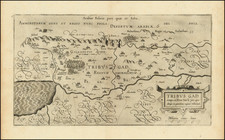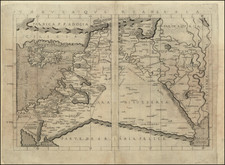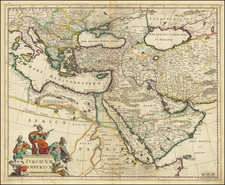Scarce map of Southern Syria, Lebanon, and the surrounding areas, created by Heinrich Keipert in Berlin in 1860.
Kiepert's map provides a detailed depiction of the region, showing the regions inhabited by major religious groups, with particular emphasis on the Druze and Maronite peoples. There is also an extensive note and key with Arabic translations.
The map emphasizes its treatment of the regions of the Druze and Maronite communities, extending eastward to Damascus. The map is a significant historical document that provides a wealth of information about the geography, culture, and society of the region in the 19th century, as well as a significant example of cartography of the period.
The Druze and Maronite communities were two of the most prominent religious groups in Syria and Lebanon in the 19th century. The Druze were a minority religious community that primarily inhabited the mountainous regions of Lebanon and the Anti-Lebanon. They practiced a secretive and syncretic religion that combined elements of Islam, Christianity, and Gnosticism, as well as Neoplatonism, Zoroastrianism, Buddhism, Hinduism, Pythagoreanism, and other philosophies and beliefs, creating a distinct and secretive theology based on an esoteric interpretation of scripture, which emphasizes the role of the mind and truthfulness. The Maronites, on the other hand, were a Christian community that primarily inhabited the mountainous regions of Lebanon. They were in communion with the Roman Catholic Church, and their liturgy was in Aramaic.
Both the Druze and Maronite communities had a complex and sometimes fraught relationship with the Ottoman Empire, which controlled the region in the 19th century. The Druze and Maronite communities were often in conflict over land, resources, and political power. Additionally, the Ottoman authorities frequently viewed the Druze and Maronite communities with suspicion and imposed various restrictions on their activities.
Despite these challenges, both communities managed to maintain their distinct identities and cultures. The Druze and Maronite communities were relatively autonomous, and they were able to preserve their own languages, customs, and traditions. They also developed their own political, economic, and social systems.












![Terra Sancta sive Palaestina exhibens non solum Regna Vetera Iuda et Israel in Suas XII Tribus Distincta . . . 1759 [The Holy Land, or Palestine, displaying not only the ancient kingdoms of Judah and Israel divided into their Twelve Tribes... 1759]](https://storage.googleapis.com/raremaps/img/small/90182.jpg)
![[ Biblical Names for Palestine ]. Carte de La Palestine Ancienne et Moderne avec le Sud du Liban et de l'Anti-Liban et les régions situées à l'est du Jourdain et de la Mer Morte, pour servir à l'étude de la Bible par A. Legendre [Map of Ancient and Modern Palestine with Southern Lebanon and Anti-Lebanon and the regions east of the Jordan and the Dead Sea, for use in the study of the Bible by A. Legendre]](https://storage.googleapis.com/raremaps/img/small/85737.jpg)
![(Czech Edition) Tabule a wymalovánj země Swaté [Map of the Holy Land]](https://storage.googleapis.com/raremaps/img/small/93473.jpg)

